- Ask a related questionWhat is a related question?A related question is a question created from another question. When the related question is created, it will be automatically linked to the original question.
This thread has been locked.
If you have a related question, please click the "Ask a related question" button in the top right corner. The newly created question will be automatically linked to this question.
Dear TI-san,
I asked about OPA313 circuit at the following URL.
And I made a board to which the following circuit was applied.
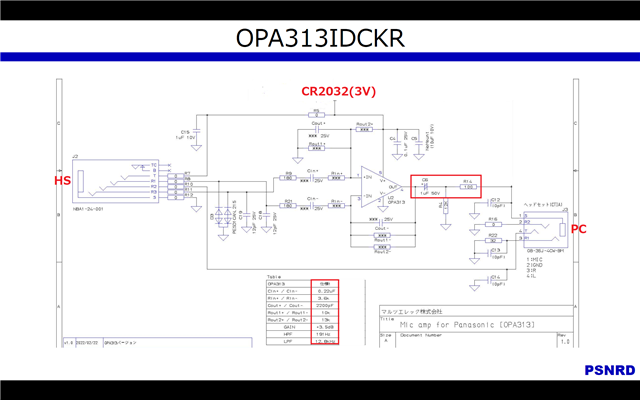
The following is an excerpt of some of QA in it.
> But decrease the cap at the output from 22µF to 1µF then. The reason: 22µF can show a much worse distortion compared to 1µF.
1
I have acquired and confirmed frequency response for your advice (THD).
The result is opposite of your advice (THD).
I want to hear your opinion.
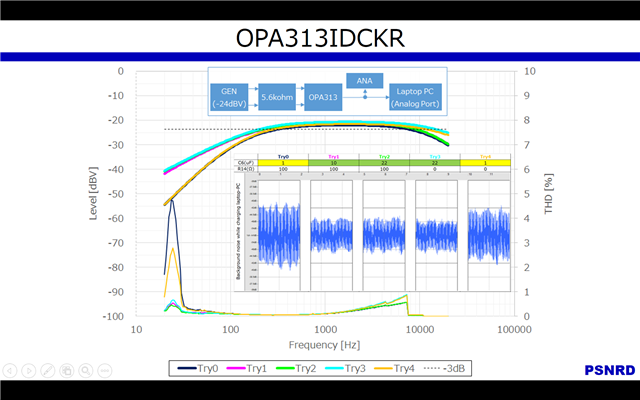
2
22uF and 1uF make a difference in background noise.
In particular, I am concerned about the fact that relationship between frequency characteristics and background noise is reversed.
I want to hear your opinion.
Click here to play this audio clip
Thanks,
S.Suzuki
Hello Suzuki-san,
Due to holiday and weekend, we will reply on Monday US.
Hi Shinya,
I originally recommended a 220n cap and a 100k resistor at the output, because this would give you the chance to take a 220n ECHU or polyester cap showing way less distortion than a ceramic 10µF X5R. But you said that a 12k resistor at the output must be used and wanted to take a 10µF cap. I recommended you to take a 1µF cap instead of 10µF because it CAN show less distortion, escpecially when you take a 1µF polyester cap instead of a ceramic 10µF X5R.
What cap are you using now? An elelctrolytic capacitor? A tantal?
Having said all this, I think that there's something wrong with the measurement or at least with the interpretation of the measuring results. In your sound sample hum can clearly be heard. This could be responsible for the peak at the very low frequencies. The hum can be injected into the output line of your amplifier, on the way to your laptop. And the 22µF cap would offer a lower impedance for the hum to signal ground via the output of OPAmp than a 1µF output cap. So the OPAmp could better suppress the injected hum. This would also explain why removing the 100R isolation resistor would decrease the hum.
So, finally, II'm sure what we see is hum and not distortion. You should check your measuring setup. Are you using shielded cables?
Also, what does mean: "Background noise while charging laptop-PC"? Shall it mean, that the "distortion" can only be seen during the charging of laptop? Shall your circuit be permantly connected to a laptop? Is this the final application?
Kai
Dear Kai-san,
Thank you reply.
Distortion
I appreciate your opinion.
I would like to determine components and constants of coupling capacitor (C6) based on your opinion.
> What cap are you using now? An elelctrolytic capacitor? A tantal?
Coupling capacitor (C6) is electrolytic capacitor.
Specifically, please refer to the following URL.
https://industrial.panasonic.com/jp/products/pt/aluminum-cap-smd/models/EEEFC1V1R0R
Hum noise
I have same perception as you.
I understand that sound sample is hum noise.
> So, finally, II'm sure what we see is hum and not distortion. You should check your measuring setup. Are you using shielded cables?
I have confirmed that there is no difference in hum noise between shielded cables and general litz wire cables.
So it is presumed that hum noise is superimposed from "ground" of the laptop computer.
> Also, what does mean: "Background noise while charging laptop-PC"? Shall it mean, that the "distortion" can only be seen during the charging of laptop?
- Hum noise occurs only during charging with laptop's AC adapter.
- Hum noise may or may not occur depending on manufacturer and model number of laptop.
- Laptops that generate hum are not stable. For example, it may not occur if you change power outlet.
> Shall your circuit be permantly connected to a laptop? Is this the final application?
Yes.
Unfortunately, laptops that generate hum noise are among recommended connected devices.
So we make it one of options to change the HPF (fc) of microphone amplifier from 200Hz to 500Hz.
From the above, I hope you can discuss ideas for reducing hum.
Thanks,
S.Suzuki
Suzuki-san,
Are you sure these are the correct PC connections?
I would expect the 'shield' would be ground.
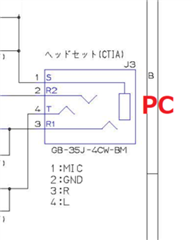
Dear Michallick-san,
Thank you reply.
> Are you sure these are the correct PC connections?
Yes.
The image you posted is an interface that connects to a laptop computer.
The interface is a CTIA headset.
> I would expect the 'shield' would be ground.
The cable is unshielded.
1
Wired headsets adapt to litz wires and are most commonly unshielded.
Therefore, even if the hum noise is reduced by using a shielded cable, it is not a countermeasure.
2
Re-posting.
- Hum noise occurs only during charging with laptop's AC adapter.
- Hum noise may or may not occur depending on manufacturer and model number of laptop.
- Laptops that generate hum are not stable. For example, it may not occur if you change power outlet.
Thanks,
S.Suzuki
Suzuki-san,
Are any of the power rails routed near the audio signal? If this is noise from the power supply into the op amp, the PSRR should be able to suppress the hum, if this is noise coupled onto the output, the op amp won't be able to suppress noise.
Best,
Jerry
Dear Jerry-san,
Thank you reply.
> Are any of the power rails routed near the audio signal?
No.
I don't think there is any crosstalk due to wiring.
Just in case, I attach board diagram and circuit diagram.
Please check you too.
Thanks,
Dear Kai-san,
Thank you reply.
Our circuit has correct connection to CTIA headset.
We have also confirmed that it is actually the correct operation.
Thanks,
S.Suzuki
Suzuki-san,
OK, I see that the right side is correct pinout for some products.
The circuit only provides 2.3dB gain. Is this enough to have a good signal to noise ratio?
With no line power applied, everything is floating. When laptop charger is connected, there can be a ground on laptop. Chargers are electrically noisy.
For ground effect test, connect charger to laptop and plug into a power strip that is turned off. If this is fine then the charger ground is not part the problem.
Then turn on power strip and test again. The difference is the charger noise. Try moving wires of application closer and father from charger cable.
Hi Shinya,
some points on your schematic:
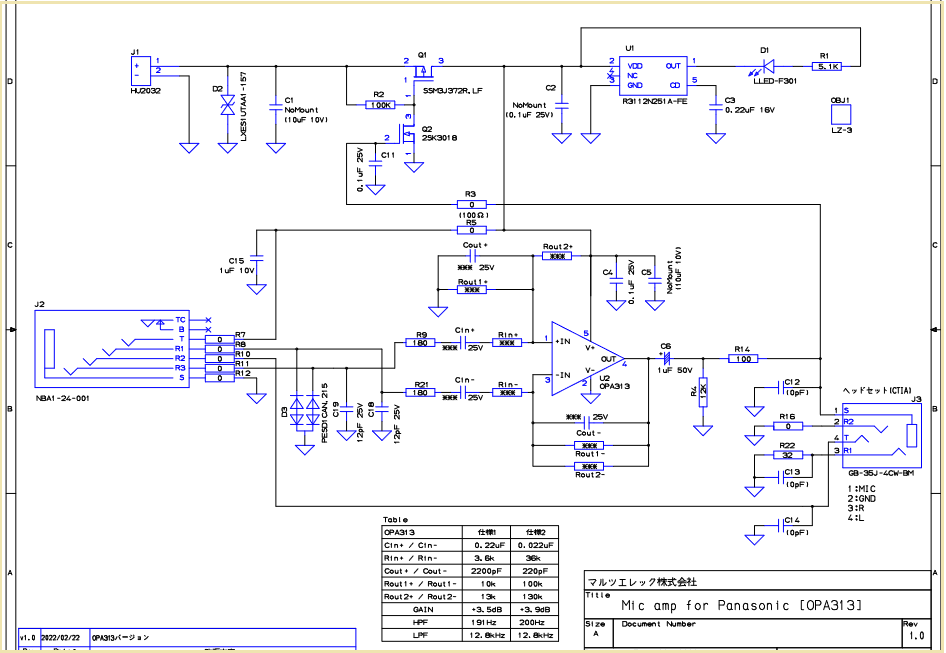
I don't understand the circuitry arround Q1 and Q2. In any case, it's no good idea to have C11 at the output of OPA313. So either you remoce C11 or you increase R3.
I guess R22 is a dummy load for the non-used earphone output? I would increase the resistance to 100R or even remove it.
Please remove R16!!!
With this sort of cheap unscreened cables a full avoidance of hum is nearly impossible. So you will always hear hum, more or less.
It would be interesting to see whether the hum is coming from the head set: Push a short-circuit plug into "J2" which shorts "R1" and "R3" to "S". Make the short-circuit connections directly at the plug and don't use any cable here. Do you still hear the hum?
Then I see an issue with "Cin+" and "Cin-". Any imbalance here will degrade the common mode rejection. You could replace for a test these both caps by way bigger capacitances. Do you still hear the hum?
By the way, what means "ANA" in your scheme above? And what is the "GEN"? Is it connected to mains earth? Is it providing true differential outputs?
Kai
Dear Michallick-san,
Thank you reply.
> The circuit only provides 2.3dB gain. Is this enough to have a good signal to noise ratio?
I can't give a direct answer because I don't know SNR judgment value.
However, I have confirmed that hum noise increases and decreases in proportion to gain of OPA313.
> For ground effect test, connect charger to laptop and plug into a power strip that is turned off. If this is fine then the charger ground is not part the problem.
I have confirmed that no hum can be heard if power strip is off.
> Then turn on power strip and test again. The difference is the charger noise. Try moving wires of application closer and father from charger cable.
I have confirmed that I can't hear hum noise unless I connect charger to smartphone or laptop.
Thanks,
S.Suzuki
Dear Kai-san,
Thank you reply.
> I don't understand the circuitry arround Q1 and Q2.
Q1 and Q2 are circuits that enable battery (J1) with microphone plug-in power (S terminal of J3).
> In any case, it's no good idea to have C11 at the output of OPA313. So either you remoce C11 or you increase R3.
C11 is essential for the stabilization of Q1 and Q2.
So I increased R3 (eg 100Ω) but it doesn't reduce hum noise.
Re-posting.
- Hum noise occurs only during charging with laptop's AC adapter.
- Hum noise may or may not occur depending on manufacturer and model number of laptop.
- Laptops that generate hum are not stable. For example, it may not occur if you change power outlet.
> I guess R22 is a dummy load for the non-used earphone output? I would increase the resistance to 100R or even remove it.
R22 is used to detect plugs in connected devices (smartphones and laptops).
Circuits with OPA313 cannot accept your suggestion as they need to be detected as a headset.
> Please remove R16!!!
R16 provides a common ground for OPA313 circuit and connected devices (smartphones and laptops).
So I can't accept your suggestion. (R16 cannot be deleted)
> Push a short-circuit plug into "J2" which shorts "R1" and "R3" to "S".
The power supply cannot be short-circuited.
So I made the following modifications.
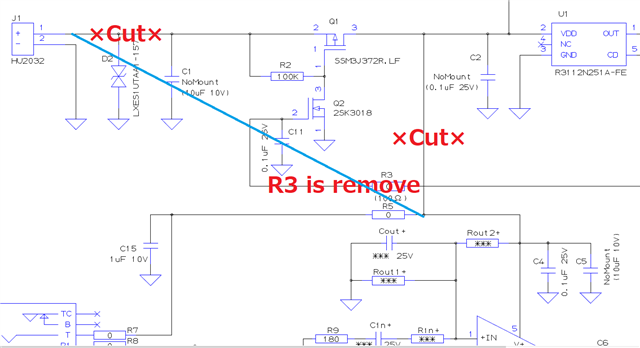
> Make the short-circuit connections directly at the plug and don't use any cable here. Do you still hear the hum?
Unfortunately I have confirmed that there is no change in hum noise.
> By the way, what means "ANA" in your scheme above? And what is the "GEN"? Is it connected to mains earth? Is it providing true differential outputs?
ANA and GEN are audio analyzer features.
ANA is an analyzer.
GND is a generator.
> Is it connected to mains earth?
You should be able to understand by looking at schematic I provided.
The ground of OPA313 is GND connected to a smartphone or laptop.
Smartphone or laptop will only be connected to main ground (public ground) while charging.
> Is it providing true differential outputs?
Sorry.
I can't understand your question.
(I understand that schematic I shared is the answer)
> And: The LED seems to consume more current than the OPA313. Is that wise?
LED is lit by U1 for only about 1 second after connecting CTIA plug.
So LEDs do not affect hum noise.
> Then I see an issue with "Cin+" and "Cin-". Any imbalance here will degrade the common mode rejection. You could replace for a test these both caps by way bigger capacitances. Do you still hear the hum?
I will answer separately.
Thanks,
S.Suzuki
Hi Shinya,
So I increased R3 (eg 100Ω) but it doesn't reduce hum noise.
The recommendation to increase R3 was not only to reduce the hum but also to prevent instability of the OPA313. An OPAmp does not want to have too high capacitive loads at the output.
R22 is used to detect plugs in connected devices (smartphones and laptops).
Circuits with OPA313 cannot accept your suggestion as they need to be detected as a headset.
Ok.
R16 provides a common ground for OPA313 circuit and connected devices (smartphones and laptops).
So I can't accept your suggestion. (R16 cannot be deleted)
Be removing I mean that it should be replaced by a short circuit. Any additional resistance at this point would ruin the performance of the whole circuit.
ANA and GEN are audio analyzer features.
ANA is an analyzer.
GND is a generator.
I ask because these components and especially any additional cabling can also introduce hum, independantly of your circuit.
So, can the hum also be heard when only the headset is connected to your circuit, your circuit to the laptop and the charger to the laptop? Or can it only be heard with "ANA" and "GEN" connected to the signal chain?
You should be able to understand by looking at schematic I provided.
No, I don't understand. I wouldn't ask otherwise
What is "ANA" and what is "GEN"? Can you show a photo of them?
LED is lit by U1 for only about 1 second after connecting CTIA plug.
This is wise, indeed
Kai
Dear Kai-san,
The reply was delayed.
Sorry.
> Then I see an issue with "Cin+" and "Cin-". Any imbalance here will degrade the common mode rejection. You could replace for a test these both caps by way bigger capacitances. Do you still hear the hum?
I changed "Cin +" and "Cin-" from 0.22uF to 1uF.
As a result, hum noise has clearly deteriorated.
I think this is a reasonable result considering difference in cutoff frequency of HPF.
> The recommendation to increase R3 was not only to reduce the hum but also to prevent instability of the OPA313. An OPAmp does not want to have too high capacitive loads at the output.
I changed "R3" from 0ohm to 100ohm.
As a result, hum noise did not change at all.
I don't think hum is involved in power system of microphone amplifier including CR2032.
> Be removing I mean that it should be replaced by a short circuit. Any additional resistance at this point would ruin the performance of the whole circuit.
R16 mounts 0 ohm.
Therefore, it is equivalent to a short circuit.
> So, can the hum also be heard when only the headset is connected to your circuit, your circuit to the laptop and the charger to the laptop? Or can it only be heard with "ANA" and "GEN" connected to the signal chain?
The former.
> What is "ANA" and what is "GEN"? Can you show a photo of them?
Answered above.
Hum noise has nothing to do with GEN or ANA connections.
P.S.
As the number of thread turns has increased, I will re-share the issue.
I want to clarify cause of "2" I posted at beginning of this thread.
So I'm asking you for help.
> 2
> 22uF and 1uF make a difference in background noise.
> In particular, I am concerned about the fact that relationship between frequency characteristics and background noise is reversed.
> I want to hear your opinion.
Thanks,
S.Suzuki
Hi Shinya,
I'm sorry, but your problem is mysterious. If you have bad luck, then the problem comes from the laptop itself and it cannot be cured by any measure. Some laptops are misconstructed and have a bad ground wiring, always making noise, when the charger is connected.
By the many many questions I ask I try to find out where excatly the noise comes from. And if I had the circuit only in my hands, I would definitely find the cause within some minutes.
Can you disconnect the headset from your circuit and make the following connections?
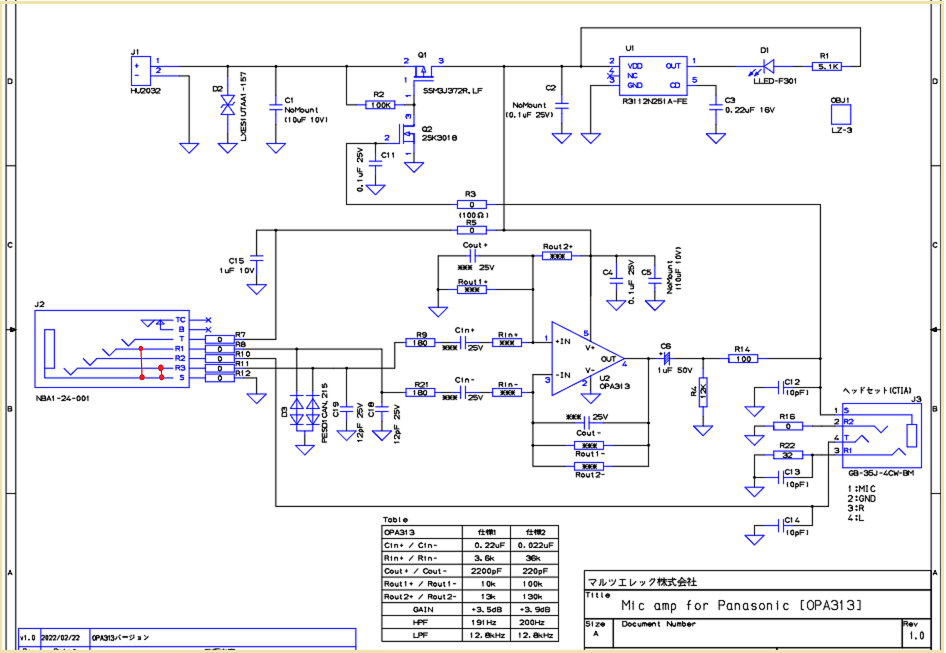
Can you still hear the hum?
Kai
Dear Kai-san,
Thank you reply.
Japan will be on a long vacation from tomorrow.
I will implement your advice on May 9th.
I'm sorry it takes time to answer.
Thanks,
S.Suzuki
Dear Kai-san,
I apologize for delay in replying to you due to my long vacation.
> Can you still hear the hum?
I can't hear hum noise.
However, although waveform is extremely slight, presence of hum noise can be confirmed.
Active means that R1 and R3 are not connected to S.
Blue is charging.
Pink is non charging.
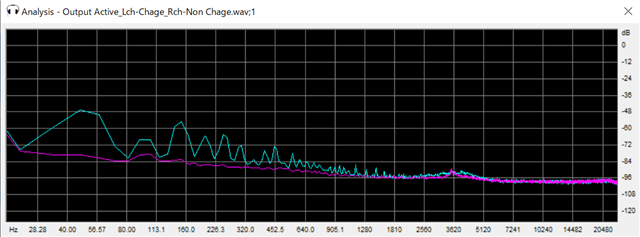
Click here to play this audio clip
Click here to play this audio clip
GND MUTE means that R1 and R3 are connected to S.
Blue is charging.
Pink is non charging.

Click here to play this audio clip
Click here to play this audio clip
Thanks,
S.Suzuki
Suzuki-san,
When I play the sound though my speakers on my USB C dock (and charger), I can't hear your noise over my noise that is much worse. I have to use my Bluetooth earbuds that gives me digital and isolated advantages. With that I can tell the difference.
There is a limit to how far you can suppress the noise with analog and limited isolation from the noise source.
Could squelch* be an answer?
*a circuit that suppresses the output of a (radio) receiver if the signal strength falls below a certain level.
Dear Michallick-san,
Thank you reply.
I know that hum noise can be reduced by adding "Auto Gain Control" or "Commander".
However, hum noise level is not constant.
So I don't think signal processing including your suggestions can completely solve my issue.
I'm sharing OPA313 schematic in this thread.
I would like to discuss how to make OPA313 circuit the best form.
Thanks,
S.Suzuki
Hi Shinya,
so can it be summarized that the hum/noise is only high when the headset is inserted into your circuit? Can it be summarized that the headset is the cause of hum/noise and not your circuit?
Hhm, the CR2032 is not very low ohmic. Hum/noise could be coupled into the supply voltage line. Can you increase C15 to 100µF for a test? Best take an aluminium electrolytic cap.
Kai
Dear Kai-san,
Thank you reply.
> so can it be summarized that the hum/noise is only high when the headset is inserted into your circuit? Can it be summarized that the headset is the cause of hum/noise and not your circuit?
Probably a fact.
In fact, I haven't checked unconnected state because I need to record hum noise.
However, hum noise is greatly reduced when not charging.
There is no doubt that it depends on connected device from this point.
> Hhm, the CR2032 is not very low ohmic. Hum/noise could be coupled into the supply voltage line. Can you increase C15 to 100µF for a test? Best take an aluminium electrolytic cap.
C15 did not affect hum noise.
Blue is 1uF.
Pink is 470uF.
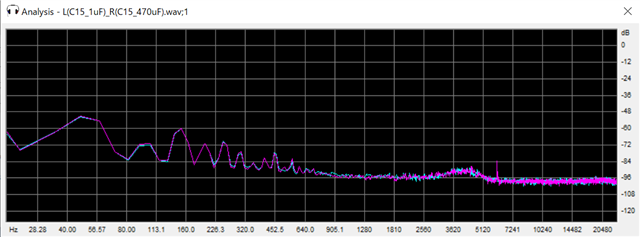
Click here to play this audio clip
Click here to play this audio clip
F.Y.I.
I removed 1uF of C15 as a trial.
C15 does not seem to contribute to hum noise.
Blue is 1uF.
Pink is no mount.
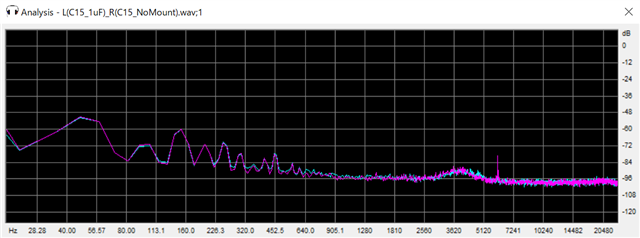
Click here to play this audio clip
Click here to play this audio clip
Thanks,
S.Suzuki